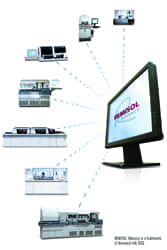
BY GARY TUFEL
“Choice is the keen cutting edge of business, the driving force behind innovation, the incentive to progress.”—Henry Ford
Critical QC/QA Issues
In a world in which labs are becoming more complex and liability-responsibility terms are becoming more prevalent when government officials talk about labs, the critical issues in quality assurance (QA) or quality control (QC) will undoubtedly vary depending on who is asked.
Among the hot topics will be uncertainty of measurement, traceability, QC rules, harmonized results, and risk management, says Andy Quintenz, scientific and professional affairs manager, Quality Systems Division, Bio-Rad Laboratories, Irvine, Calif. These are important, but the issues labs struggle with, affecting lab quality, are of a higher order. These issues are budget, priorities, staffing, and education, as Quintenz notes below:
• Budget. As hospitals grapple with decreasing payments, test quality improvement projects rarely get funded or attract the attention they deserve. “Hospital management assumes that high quality is a given in the lab, and when laboratory issues make it onto their initiatives list, they tend to be more along the lines of improving efficiency, increasing revenue streams, or decreasing costs. That leads to the challenge of priority-setting.”
• Priorities. Few labs can truly dictate their own priorities. When labs do get a chance to work on improvements, they are often not on issues of their own choosing, but rather on issues that were identified by assessors. These are important projects, but may not speak to internally identified improvements that would improve customer satisfaction. Furthermore, there is an issue of “priority du jour”: Patient-accessible records, electronic health records (EHR), risk management, PT referrals, turnaround time, and others. “These headline-grabbing issues are important, but which is more important and where does the lab start? It’s a question that is frequently decided by hospital management and not lab staff.
• Staffing. “We’ve long heard the issue of Baby Boomer med tech retirement. As this continues to unfold, there is a gap of experience and knowledge, leaving the workforce that is not being replenished by recent graduates from MLT and MT/CLS programs. Many labs feel understaffed to support their volume of testing and are left to find ways to adopt workflows that accommodate more staff without the advanced education or licensing preferred, or required.”
• Education. Staffing levels and budget cuts have affected the ability of lab personnel to attend conferences and gain exposure to a wide variety of topics and viewpoints. Much learning is online or vendor-supplied. With so many new test methodologies, undergraduate programs are challenged to provide well-developed education without additional required courses; and as more and more reliance is placed on automation and technology, QA and QC become critical. Yet there are fundamental, significant gaps between QA/QC best practices and the knowledge base of the staff. While quality is reinforced, there are relatively few hours spent on education about quality systems, quality assurance, and quality control. “This is critical and is why Bio-Rad has such a strong focus on education. We continue to develop self-paced and on-demand educational materials, and will be rolling out new opportunities and activities in 2014.”
 |
“It’s cost-prohibitive to bring many [new expensive molecular and genetic tests] on board, and send-outs can eat up margins. Some labs are starting to split new tests between sister labs, so they all don’t have to run the same menu.” —Andy Quintenz, scientific and professional affairs manager, Quality Systems Division, Bio-Rad Laboratories |
At a recent seminar Quintenz attended, a lab director was asked where he wished to focus his priorities. The lab director said he would concentrate on activities that would reframe the lab’s image to value-added versus being a cost center. If forced to focus solely on what he could control, the lab director said he would standardize across his facility’s health system, which would reduce errors and simplify training and flexibility of staff—knowing that the long-term payoff would be reduced costs accruing from efficiencies and improved value for the clinicians and patients.
Quintenz says key topics also include:
• A plethora of new tests: How do hospitals stay competitive in lab testing with so many new, expensive molecular and genetic tests being offered by vendors each month? “It’s cost-prohibitive to bring many on board, and send-outs can eat up margins. Some labs are starting to split new tests between sister labs, so they all don’t have to run the same menu.”
• On standardization: As hospital groups expand, by acquisition of new hospitals or physician groups, standardization of lab testing becomes an important issue. It is challenging to oversee labs with a variety of instruments, protocols, reference intervals, etc. Standardizing simplifies this issue for labs, and becomes a much more immediate solution to the question of harmonizing results across platforms.
Choosing Wisely
Circling back to Ford’s principle, it is as important in the area of quality control as it is in any business, as an increasing choice of widely available, quality products help improve the accuracy of patient sample testing, improving diagnosis, and, ultimately, saving lives, says Steven Jordan, global manager, QC, Randox Laboratories, UK.
As consumers, we live in a world of choice and benefit accordingly. “Why then, when it comes to QC, should US laboratories not enjoy the same levels of choice from a proper market, free from dominance by a handful of players?” Jordan asks.
Labs are faced with an array of controls of differing quality and varying costs, Jordan says, noting key factors for consideration.
The choice of using first-party versus third-party controls is an important one for labs, he says. Many instrument and reagent manufacturers provide dedicated (first-party) quality controls for use with their own reagents and analyzers. These controls are not as effective as third-party controls as they often mask a multitude of weaknesses, Jordan says.
Third-party controls are not designed or optimized for use with a specific test or system. As such, they mirror the performance of patient samples and provide an unbiased, independent assessment of analytical performance, he notes, adding that in human sample testing, the controls, where possible, should be made from 100% human serum.
| “Multianalyte QC can dramatically reduce the number of controls used in a laboratory. By replacing multiple, instrument-specific controls with a single multianalyzer product, laboratories can save time and money.” —Steven Jordan, global manager, QC, Randox Laboratories |
Some QC manufacturers, in an attempt to keep costs down and remain competitive, add constituents of animal origin to their control products (often described as “human-based”). The use of such controls can cause problems with antibody-based tests due to differences in antibody specificity toward nonhuman
components, he says.
Human serum controls, which are made from quality-sourced and highly screened human blood, will ensure safety and consistency. The use of preservatives and stabilizers, often added by QC manufacturers to prolong the shelf life of products, can cause interference problems resulting in analytical errors. With budgetary constraints affecting most labs, the need to rerun QC tests often makes it a false economy to opt for cheaper, lower-quality QC products, Jordan says.
“Laboratories are faced with an often bewildering choice of controls in a range of formats—ready-to-use liquids, liquid-frozen, lyophilized, assayed, or unassayed,” Jordan says. “Depending on the particular needs of your laboratory, you should be able to meet your specific needs if you shop around.”
Concentrations and levels can vary between control products, which can result in unrealistic values being assigned, parameter imbalances, or a lack of differentiation between levels, and controls that do not completely cover the clinical range. This can force labs to purchase additional, and often expensive, low- or high-level controls, Jordan adds.
“Look instead for a QC provider that offers controls to cover the complete clinical range, with accurately assigned target values and ranges for each analyte,” he says. “This will allow laboratories to reliably measure the accuracy and precision of
their methods.
“In addition, multianalyte QC can dramatically reduce the number of controls used in a laboratory,” Jordan adds. “By replacing multiple, instrument-specific controls with a single multianalyzer product, laboratories can save time and money. There’s a world of choice out there, and by looking beyond your usual suppliers you might just find solutions that better fit your needs.”
|
Beckman Coulter Offers REMISOL Data Management System for Improved Quality Control |
RELATED CONTENT:
|
Gary Tufel is a contributing writer for CLP. For more information, contact Editor Judy O’Rourke, [email protected]



